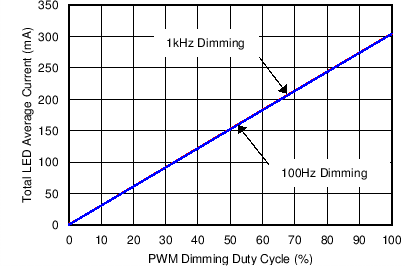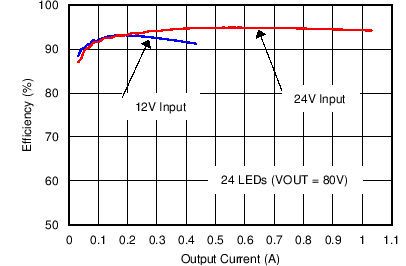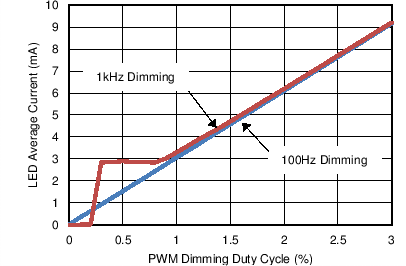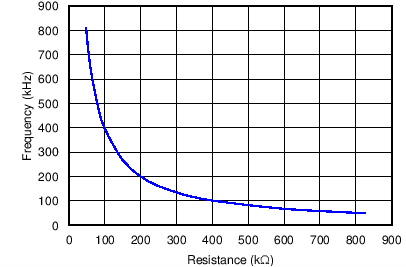SLVSC25B July 2013 – June 2017 TPS61197
PRODUCTION DATA.
- 1 Features
- 2 Applications
- 3 Description
- 4 Revision History
- 5 Pin Configuration and Functions
- 6 Specifications
-
7 Detailed Description
- 7.1 Overview
- 7.2 Functional Block Diagram
- 7.3 Feature Description
- 7.4
Device Functional Modes
- 7.4.1
Protections
- 7.4.1.1 Switch Current Limit Protection Using the ISNS Pin
- 7.4.1.2 LED Open Protection
- 7.4.1.3 Schottky Diode Open Protection
- 7.4.1.4 Schottky Diode Short Protection
- 7.4.1.5 IFB Overvoltage Protection
- 7.4.1.6 Output Overvoltage Protection Using the OVP Pin
- 7.4.1.7 IFB Short-to-Ground Protection
- 7.4.1.8 Thermal Shutdown
- 7.4.1
Protections
- 8 Application and Implementation
- 9 Power Supply Recommendations
- 10Layout
- 11Device and Documentation Support
- 12Mechanical, Packaging, and Orderable Information
Package Options
Mechanical Data (Package|Pins)
- D|16
Thermal pad, mechanical data (Package|Pins)
Orderable Information
6 Specifications
6.1 Absolute Maximum Ratings
over operating free-air temperature range (unless otherwise noted)(1)| MIN | MAX | UNIT | ||
|---|---|---|---|---|
| Voltage range(2) | Pin VIN | –0.3 | 33 | V |
| Pin FAULT | –0.3 | VIN | ||
| Pin ISNS, IFB | –0.3 | 3.3 | ||
| Pin EN, PWM, VDD, GDRV, IDRV | –0.3 | 20 | ||
| Pin GDRV 10-ns transient | –2 | 20 | ||
| All other pins | –0.3 | 7 | ||
| Continuous power dissipation | See Thermal Information | |||
| Operating junction temperature range | –40 | 150 | °C | |
| Storage temperature, Tstg | –65 | 150 | °C | |
(1) Stresses beyond those listed under Absolute Maximum Ratings may cause permanent damage to the device. These are stress ratings only, which do not imply functional operation of the device at these or any other conditions beyond those indicated under Recommended Operating Conditions. Exposure to absolute-maximum-rated conditions for extended periods may affect device reliability.
(2) All voltage values are with respect to network ground terminal.
6.2 ESD Ratings
| VALUE | UNIT | |||
|---|---|---|---|---|
| V(ESD) | Electrostatic discharge | Human-body model (HBM), per ANSI/ESDA/JEDEC JS-001(1) | ±2000 | V |
| Charged-device model (CDM), per JEDEC specification JESD22-C101(2) | ±1000 | |||
| Machine model | 200 | |||
(1) JEDEC document JEP155 states that 500-V HBM allows safe manufacturing with a standard ESD control process.
(2) JEDEC document JEP157 states that 250-V CDM allows safe manufacturing with a standard ESD control process.
6.3 Recommended Operating Conditions
over operating free-air temperature range (unless otherwise noted)(1)| MIN | MAX | UNIT | ||
|---|---|---|---|---|
| VIN | Input voltage range | 8 | 30 | V |
| VOUT | Output voltage range | VIN | 300 | V |
| L1 | Inductor | 4.7 | 470 | µH |
| CIN | Input capacitor | 10 | µF | |
| COUT | Output capacitor | 1 | 220 | µF |
| fSW | Boost regulator switching frequency | 50 | 800 | kHz |
| fDIM | PWM dimming frequency | 0.09 | 22 | kHz |
| TA | Operating ambient temperature | –40 | 85 | °C |
| TJ | Operating junction temperature | –40 | 125 | °C |
(1) Customers need to verify the component value in their application if the values are different from the recommended values.
6.4 Thermal Information
| THERMAL METRIC(1) | TPS61197 | UNITS | |
|---|---|---|---|
| D (SOIC) | |||
| 16 PINS | |||
| RθJA | Junction-to-ambient thermal resistance | 85.8 | °C/W |
| RθJCtop | Junction-to-case (top) thermal resistance | 44.5 | °C/W |
| RθJB | Junction-to-board thermal resistance | 43.3 | °C/W |
| RψJT | Junction-to-top characterization parameter | 13.5 | °C/W |
| RψJB | Junction-to-board characterization parameter | 42.9 | °C/W |
(1) For more information about traditional and new thermal metrics, see Semiconductor and IC Package Thermal Metrics.
6.5 Electrical Characteristics
VIN = 24 V, TA = –40°C to 85°C, typical values are at TA = 25°C, EC1 = 470 μF, EC2 = 22 μF (unless otherwise noted)| PARAMETER | TEST CONDITIONS | MIN | TYP | MAX | UNIT | |
|---|---|---|---|---|---|---|
| POWER SUPPLY | ||||||
| VIN | Input voltage range | 8 | 30 | V | ||
| VVIN_UVLO | Undervoltage lockout threshold | VIN falling | 6.5 | 7 | V | |
| VVIN_HYS | VIN UVLO hysteresis | 300 | mV | |||
| IQ_VIN | Operating quiescent current into VIN | Device enabled, no switching, VIN = 30 V | 2 | mA | ||
| ISD | Shutdown current | VIN = 12 V VIN = 30 V |
25 50 |
µA | ||
| VDD | Regulation voltage for internal circuit | 0 mA < IDD < 15 mA | 6.6 | 7 | 7.4 | V |
| EN and PWM | ||||||
| VH | Logic high input on EN, PWM | VIN = 8 V to 30 V | 1.6 | V | ||
| VL | Logic low input on EN, PWM | VIN = 8 V to 30 V | 0.75 | V | ||
| RPD | Pulldown resistance on EN, PWM | 400 | 800 | 1600 | kΩ | |
| UVLO | ||||||
| VUVLOTH | Threshold voltage at UVLO pin | 1.204 | 1.229 | 1.253 | V | |
| IUVLO | UVLO input bias current | VUVLO = VUVLOTH – 50 mV | –0.1 | 0.1 | µA | |
| VUVLO = VUVLOTH + 50 mV | –4.4 | -3.9 | –3.3 | |||
| SOFT START | ||||||
| ISS | Soft start charging current | PWM dimming on, VREF< 2 V | 200 | µA | ||
| CURRENT REGULATION | ||||||
| VIFB_REG | IFB pin regulation voltage | TJ = 25°C to 85°C | 293 | 300 | 307 | mV |
| VIFB_SCP | IFB short to ground protection threshold | 200 | mV | |||
| VIFB_OVP | IFB over voltage protection threshold | 1 | 1.1 | 1.2 | V | |
| IIFB_LEAK | IFB pin leakage current | VIFB = 300 mV | –100 | 100 | nA | |
| BOOST REFERENCE VOLTAGE | ||||||
| VREF | Reference voltage range for boost controller | 0 | 3.5 | V | ||
| IREF_LEAK | Leakage current at REF | TJ = –40°C to 85°C | –25 | 25 | nA | |
| OSCILLATOR | ||||||
| VFSW | FSW pin reference voltage | 1.8 | V | |||
| ERROR AMPLIFIER | ||||||
| ISINK | Comp pin sink current | VOVP = VREF + 200 mV, VCOMP = 1V | 20 | µA | ||
| ISOURCE | Comp pin source current | VOVP = VREF – 200 mV, VCOMP = 1V | 20 | µA | ||
| GmEA | Error amplifier transconductance | 90 | 120 | 150 | µS | |
| REA | Error amplifier output resistance | 20 | MΩ | |||
| GATE DRIVER | ||||||
| RGDRV_SRC | Gate driver impedance when sourcing | VGDRV = 7 V, IGDRV = –20 mA | 5 | 10 | Ω | |
| RGDRV_SNK | Gate driver impedance when sinking | VDD = 7 V, IGDRV = 20 mA | 2 | 5 | Ω | |
| IGDRV_SRC | Gate driver source current | VDD = 7 V, VGDRV = 5 V | 200 | mA | ||
| IGDRV_SNK | Gate driver sink current | VDD = 7 V, VGDRV = 2 V | 400 | mA | ||
| VPWM_OCP | Overcurrent detection threshold during PWM | VIN = 8 V to 30 V, TJ = 25°C to 125°C | 376 | 400 | 424 | mV |
| VPFM_OCP | Overcurrent detection threshold during PFM | 180 | mV | |||
| OVP | ||||||
| VOVPTH | Overvoltage protection threshold | 2.98 | 3.04 | 3.1 | V | |
| IOVP_LEAK | Leakage current at OVP pin | –100 | 0 | 100 | nA | |
| FAULT INDICATOR | ||||||
| IFLT_H | Leakage current at high impedance | VFLT = 24 V | 1 | nA | ||
| IFLT_L | Sink current at low output | VFLT = 1 V | 2 | 5 | mA | |
| THERMAL SHUTDOWN | ||||||
| TSTDN | Thermal shutdown threshold | 150 | °C | |||
| THYS | Thermal shutdown threshold hysteresis | 15 | °C | |||
6.6 Switching Characteristics
over operating free-air temperature range (unless otherwise noted)| PARAMETER | TEST CONDITIONS | MIN | TYP | MAX | UNIT | |
|---|---|---|---|---|---|---|
| ƒSW | Switching frequency | R = 200 kΩ | 187 | 200 | 213 | kHz |
| D(max) | Maximum duty cycle | fSW = 200 kHz | 90% | 94% | 98% | |
| ton(min) | Minimum pulse width | 300 | ns | |||
| ƒEA | Error amplifier crossover frequency | 1000 | kHz | |||
6.7 Typical Characteristics
Table 1. Table Of Graphs
| See Figure 18 | ||
|---|---|---|
| TITLE | TEST CONDITIONS | FIGURE |
| Dimming Linearity | 24 LEDs (VOUT = 80 V), VIN = 24 V | Figure 1 |
| Dimming Linearity at Small Dimming Duty Cycle | 24 LEDs (VOUT = 80 V), VIN = 24 V | Figure 2 |
| DC Load Efficiency | fSW = 130 kHz | Figure 3 |
| Switching Frequency Setting | VIN = 24 V | Figure 4 |
| Boost Switching Waveform | VIN = 24 V, VOUT = 80 V, IOUT = 300 mA | Figure 5 |
| Dimming Waveform (2% Dimming) | VIN = 24 V, VOUT = 80 V, IOUT = 300 mA, 100-Hz dimming frequency | Figure 6 |
| Startup Waveform (1% Dimming) | 100-Hz dimming frequency, 1% dimming duty cycle | Figure 7 |
| Startup Waveform (100% Dimming) | 100-Hz dimming frequency, 100% dimming duty cycle | Figure 8 |
| Shutdown Waveform (1% Dimming) | 100-Hz dimming frequency, 1% dimming duty cycle | Figure 9 |
| Shutdown Waveform (100% Dimming) | 100-Hz dimming frequenc, 100% dimming duty cycle | Figure 10 |
| LED Open Protection (1% Dimming) | 100-Hz dimming frequenc, 1% dimming duty cycle | Figure 11 |
| LED Open Protection (100% Dimming) | 100-Hz dimming frequenc, 100% Dimming Duty Cycle | Figure 12 |
| LED String Short Protection (1% Dimming) | 100-Hz dimming frequency, 1% dimming duty cycle | Figure 13 |
| LED String Short Protection (100% Dimming) | 100-Hz dimming frequency, 1% dimming duty cycle | Figure 14 |













